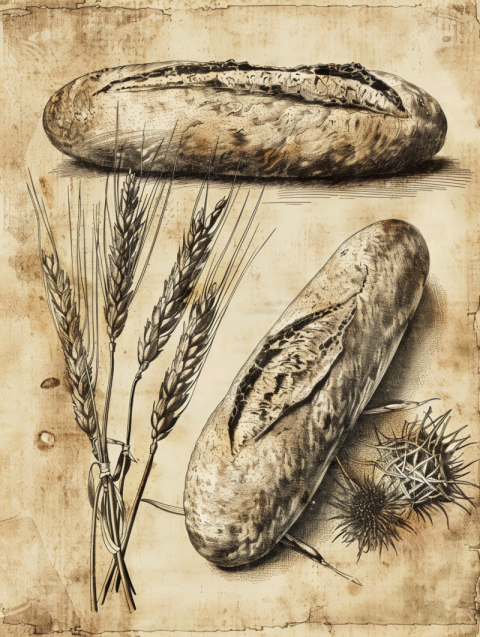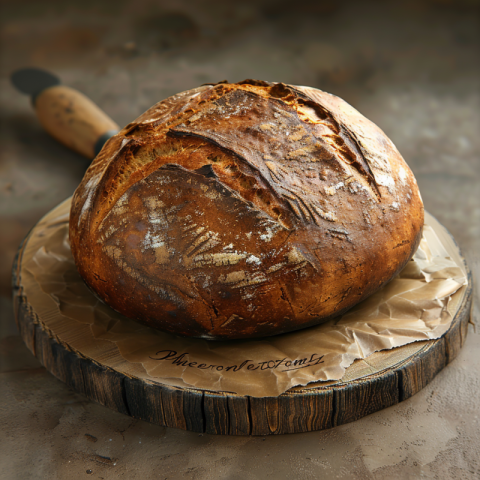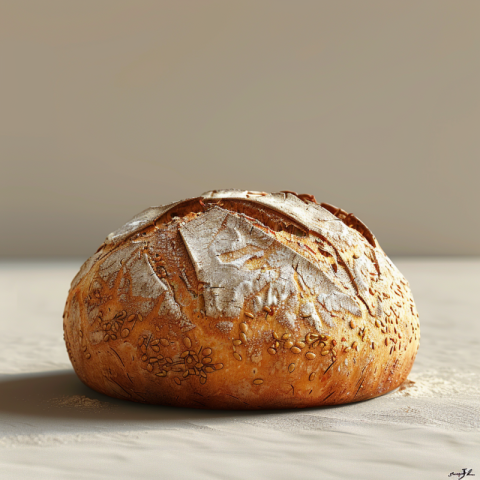











read: A Staple Food Through the Ages - History, Types, and Baking
Bread, a fundamental food made primarily from flour, water, and yeast, has been a cornerstone of human diets for millennia. Its simple ingredients belie a complex history, intertwined with the development of agriculture, the rise of civilizations, and the evolution of culinary traditions. From rustic loaves baked in earthen ovens to the vast array of commercially produced breads available today, bread continues to nourish and sustain people worldwide, offering a diverse range of flavors, textures, and cultural significance.
1. The Dawn of Bread: Ancient Grains and Early Baking
The history of bread is deeply connected to the history of agriculture:
- Evidence suggests that humans were making and consuming bread-like products as far back as 30,000 years ago, during the Upper Paleolithic period.
- The cultivation of grains, such as wheat, barley, and rye, beginning around 10,000 BCE in the Fertile Crescent, provided the foundation for bread making.
- Early breads were likely unleavened, flatbreads cooked on hot stones or in ashes.
- The discovery of fermentation, likely accidental, led to the development of leavened bread, which is lighter and more porous.
- Ancient Egyptians were skilled bakers and are credited with developing the first known leavened bread around 4000 BCE, using wild yeasts.
2. Types of Bread: A Global Tapestry of Shapes and Flavors
Bread comes in countless varieties, reflecting different cultures, ingredients, and baking techniques:
- Leavened Bread: Bread that uses yeast or another leavening agent to rise.
- White Bread: Made with refined wheat flour, often soft and fluffy.
- Whole Wheat Bread: Made with whole wheat flour, containing the bran and germ, offering more fiber and nutrients.
- Sourdough Bread: Made with a fermented starter culture, resulting in a tangy flavor and chewy texture.
- Rye Bread: Made with rye flour, often dense and dark with a distinctive flavor.
- Multigrain Bread: Made with a mixture of different grains, such as wheat, oats, barley, and rye.
- Unleavened Bread (Flatbread): Bread that does not use yeast or other leavening agents.
- Tortilla: A thin, round flatbread made from corn or wheat flour, common in Mexican cuisine.
- Pita: A pocket bread popular in the Middle East and Mediterranean.
- Naan: A leavened flatbread traditionally baked in a tandoor oven, common in Indian cuisine.
- Matzah: An unleavened flatbread eaten by Jews during Passover.
- Sweet Breads: Breads that contain added sugar, fruits, nuts, or spices.
- Banana Bread: A moist, sweet bread made with mashed bananas.
- Zucchini Bread: Similar to banana bread but made with zucchini.
- Cinnamon Rolls: Sweet rolls made with cinnamon and sugar, often topped with icing.
3. Bread Ingredients: The Essentials of Baking
The basic ingredients for most breads include:
- Flour: The primary ingredient, providing structure to the bread. Wheat flour is most commonly used, but other flours, such as rye, barley, and oat flour, can also be used.
- Water: Hydrates the flour and activates the yeast.
- Yeast: A leavening agent that ferments sugars in the flour, producing carbon dioxide gas that causes the bread to rise.
- Salt: Enhances flavor and helps to control yeast activity.
- Optional Ingredients: Sugar, fat (oil, butter), eggs, milk, and other ingredients can be added to modify the flavor, texture, and nutritional content of the bread.
4. The Art and Science of Bread Baking: From Mixing to Kneading
Baking bread is both an art and a science, requiring precision and an understanding of the underlying processes:
- Mixing: The ingredients are combined to form a dough.
- Kneading: The dough is worked to develop the gluten, a protein in flour that gives bread its structure and elasticity.
- Fermentation (Rising): The dough is allowed to rest in a warm place, allowing the yeast to ferment and produce carbon dioxide, causing the dough to rise.
- Proofing: The final rise of the dough before baking.
- Baking: The dough is baked in an oven, where the heat kills the yeast, sets the structure of the bread, and creates a crust.
- Cooling: The bread is allowed to cool completely before slicing and serving.
5. Bread Around the World: Cultural and Regional Variations
Bread is a staple food in many cultures, each with its own unique bread-making traditions:
- France: Baguettes, croissants, and pain de campagne are iconic French breads.
- Italy: Ciabatta, focaccia, and pane di Altamura are just a few examples of Italian breads.
- Germany: Known for its dark, dense rye breads, such as pumpernickel.
- Ireland: Soda bread, made with baking soda instead of yeast, is a traditional Irish bread.
- Middle East: Pita bread, lavash, and other flatbreads are staples of Middle Eastern cuisine.
- India: Naan, roti, and paratha are popular Indian flatbreads.
6. Bread and Society: Symbolism and Significance
Bread has held symbolic and cultural significance in many societies throughout history:
- It's often associated with sustenance, nourishment, and life itself.
- In some religions, bread plays a central role in rituals and ceremonies, such as the Eucharist in Christianity.
- Bread has been used as a symbol of hospitality, sharing, and community.
- The phrase "breaking bread" is often used to describe the act of sharing a meal and building relationships.
7. The Future of Bread
- Artisan bread baking is experiencing a resurgence, with a renewed focus on traditional techniques and high-quality ingredients.
- There is a growing demand for healthier bread options, such as whole-grain breads and breads made with alternative flours.
- The rise of gluten-free diets has led to the development of a wide range of gluten-free bread products.
Conclusion:
Bread, in its myriad forms, is a testament to human ingenuity and our enduring relationship with food. From its ancient origins to its central role in cuisines worldwide, bread has nourished, sustained, and connected people across cultures and throughout history. Whether you prefer a crusty sourdough, a soft white loaf, or a flavorful flatbread, the world of bread offers a diverse and delicious landscape to explore. As baking techniques continue to evolve and our understanding of nutrition grows, bread will undoubtedly remain a cherished staple, adapting to new tastes and preferences while retaining its fundamental place at the heart of our tables and traditions.
Bread, types of bread, bread recipes, how to make bread, baking bread, bread ingredients, white bread, whole wheat bread, sourdough bread, rye bread, multigrain bread, flatbread, tortilla, pita bread, naan, baguette, ciabatta, focaccia, brioche, challah, artisan bread, bread flour, yeast, baking powder, baking soda, kneading, proofing, baking, bread history, bread machine, bread maker, bread and butter, sandwich bread, toast, gluten-free bread, healthy bread, bread shop near me, buy bread online, bakery.

